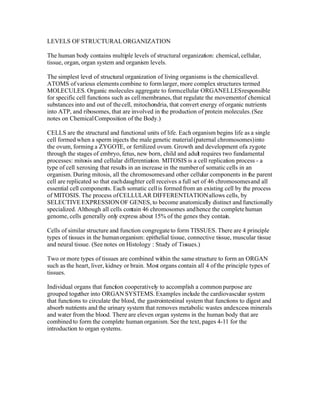
Levels Of Structural Organization
- 1. LEVELS OF STRUCTURAL ORGANIZATION The human body contains multiple levels of structural organization: chemical, cellular, tissue, organ, organ system and organism levels. The simplest level of structural organization of living organisms is the chemical level. ATOMS of various elements combine to form larger, more complex structures termed MOLECULES. Organic molecules aggregate to form cellular ORGANELLES responsible for specific cell functions such as cell membranes, that regulate the movement of chemical substances into and out of the cell, mitochondria, that convert energy of organic nutrients into ATP, and ribosomes, that are involved in the production of protein molecules. (See notes on Chemical Composition of the Body.) CELLS are the structural and functional units of life. Each organism begins life as a single cell formed when a sperm injects the male genetic material (paternal chromosomes) into the ovum, forming a ZYGOTE, or fertilized ovum. Growth and development ofa zygote through the stages of embryo, fetus, new born, child and adult requires two fundamental processes: mitosis and cellular differentiat on. MITOSIS is a cell replication process - a i type of cell xeroxing that results in an increase in the number of somatic cells in an organism. During mitosis, all the chromosomes and other cellular components in the parent cell are replicated so that each daughter cell receives a full set of 46 chromosomes and all essential cell components. Each somatic cell is formed from an existing cell by the process of MITOSIS. The process of CELLULAR DIFFERENTIATION allows cells, by SELECTIVE EXPRESSION OF GENES, to become anatomically distinct and functionally specialized. Although all cells contain 46 chromosomes and hence the complete human genome, cells generally only express about 15% of the genes they contain. Cells of similar structure and function congregate to form TISSUES. There are 4 principle types of tissues in the human organism: epithelial tissue, connective tissue, muscular tissue and neural tissue. (See notes on Histology : Study of Tissues.) Two or more types of tissues are combined within the same structure to form an ORGAN such as the heart, liver, kidney or brain. Most organs contain all 4 of the principle types of tissues. Individual organs that function cooperatively to accomplish a common purpose are grouped together into ORGAN SYSTEMS. Examples include the cardiovascular system that functions to circulate the blood, the gastrointestinal system that functions to digest and absorb nutrients and the urinary system that removes metabolic wastes andexcess minerals and water from the blood. There are eleven organ systems in the human body that are combined to form the complete human organism. See the text, pages 4-11 for the introduction to organ systems.